
|
Now it is bright as 8.3 mag (Aug. 1, Carlos Labordena). It is observable at 7.5-8 mag for a long time from 2022 to 2023. In the Northern Hemisphere, it stays observable in good condition until autumn. However, it is not observable at the high light from autumn to 2023 summer. In the Southern Hemisphere, it stays observable in good condition for a long time.
Date(TT) R.A. (2000) Decl. Delta r Elong. m1 Best Time(A, h)
Aug. 6 16 20.12 -12 50.1 1.900 2.465 111 8.3 20:33 ( 23, 39)
Aug. 13 16 11.72 -15 40.4 1.956 2.410 103 8.3 20:24 ( 29, 34)
|
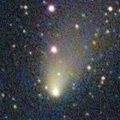
|
It brightened up to 10.4 mag from June to July (July 22, Ken-ichi Kadota). Now it is not observable. In the Souther Hemisphere, it will appear in the morning sky at 12 mag in October. It will never be observable again in the Northern Hemisphere.
Date(TT) R.A. (2000) Decl. Delta r Elong. m1 Best Time(A, h)
Aug. 6 10 14.90 8 55.4 1.991 1.086 19 9.7 20:33 (108,-10)
Aug. 13 10 30.71 3 16.0 2.011 1.104 19 9.8 20:24 (104,-14)
|

|
Now it is very bright as 9.8 mag (June 25, Marco Goiato). It will be fading gradually after this. In the Southen Hemisphere, it stays observable in good condition for a long time, although it becomes temporarily low in August. In the Northern Hemisphere, it is not observable until November when it fades down to 13 mag.
Date(TT) R.A. (2000) Decl. Delta r Elong. m1 Best Time(A, h)
Aug. 6 9 41.93 -43 27.2 2.187 1.913 60 11.0 20:33 ( 60,-42)
Aug. 13 9 47.93 -41 59.7 2.304 1.947 56 11.2 20:24 ( 63,-44)
|

|
It brightened up to 8.3 mag in winter (Jan. 6, Toshiyuki Takahashi). Now it is fading. Now it is not observable. It will appear in the morning sky again in September in the Southern Hemisphere, or in October in the Northern Hemisphere.
Date(TT) R.A. (2000) Decl. Delta r Elong. m1 Best Time(A, h)
Aug. 6 8 41.25 -0 45.7 4.972 4.022 18 11.6 3:37 (251,-26)
Aug. 13 8 48.28 -1 58.4 4.991 4.051 19 11.6 3:44 (257,-21)
|

|
Now it is 12.3 mag (July 19, Thomas Lehmann). It brightens up to 11-12 mag from summer to autumn. It stays observable in good condition in the Southern Hemisphere. In the Northern Hemisphere, it becomes extremely low from August to September. Michael Jager detected its two fragments at 19 mag.
Date(TT) R.A. (2000) Decl. Delta r Elong. m1 Best Time(A, h)
Aug. 6 12 32.32 -2 20.7 1.159 1.014 55 11.9 20:33 ( 79, 11)
Aug. 13 12 54.85 -6 21.7 1.117 0.990 55 11.7 20:24 ( 75, 9)
|

|
Now it is bright as 12.4 mag (July 20, Ken-ichi Kadota). It stays 12 mag for a while. It becomes unobservable from August to November in the Northern Hemisphere, or from September to December in the Southern Hemisphere.
Date(TT) R.A. (2000) Decl. Delta r Elong. m1 Best Time(A, h)
Aug. 6 12 32.97 -3 15.6 4.759 4.270 55 12.2 20:33 ( 78, 10)
Aug. 13 12 39.52 -3 6.9 4.851 4.277 50 12.3 20:24 ( 80, 8)
|

|
Now it is 13.7 mag (July 25, Chris Wyatt). It will brighten up to 12.5 mag in summer. In the Southern Hemisphere, it stays observable in excellent condition for a long time. In the Northern Hemisphere, it locates extremely low for a while.
Date(TT) R.A. (2000) Decl. Delta r Elong. m1 Best Time(A, h)
Aug. 6 17 15.66 -51 1.0 2.300 2.985 123 12.6 20:33 ( 3, 4)
Aug. 13 17 2.54 -47 28.4 2.381 2.976 116 12.6 20:24 ( 8, 7)
|
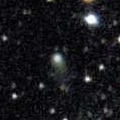
|
Now it is bright as 12.8 mag (Aug. 1, Toshihiko Ikemura, Hirohisa Sato). It will approach to Earth down to 0.29 a.u. in 2023 February, and it is expected to brighten up to 5 mag. In the Northern Hemisphere, it stays observable in excellent condition. In the Southern Hemisphere, it becomes unobservable from late September to early February.
Date(TT) R.A. (2000) Decl. Delta r Elong. m1 Best Time(A, h)
Aug. 6 17 20.93 35 46.0 2.117 2.584 105 12.8 20:33 (106, 87)
Aug. 13 17 3.27 35 15.5 2.127 2.504 99 12.6 20:24 ( 95, 80)
|
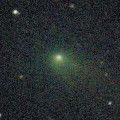
|
Now it is 12.5 mag (Aug. 4, Michael Jager). It stays observable in good condition after this. But it will be fading gradually after this.
Date(TT) R.A. (2000) Decl. Delta r Elong. m1 Best Time(A, h)
Aug. 6 1 37.50 4 21.1 1.501 2.067 108 12.8 3:37 (330, 56)
Aug. 13 1 40.34 4 12.6 1.469 2.108 115 12.9 3:44 (345, 58)
|
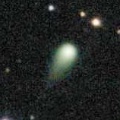
|
Now it is 13.3 mag (Aug. 4, Z. Banfalvy). It is expected to brighten up to 10 mag in 2023. In the Northern Hemisphere, it stays observable in good condition until 2023 autumn, although it becomes very low temporarily in summer. In the Southern Hemipshere, it stays unobservable until 2023 summer.
Date(TT) R.A. (2000) Decl. Delta r Elong. m1 Best Time(A, h)
Aug. 6 10 6.61 53 3.4 4.479 3.736 38 13.0 20:33 (144, 16)
Aug. 13 10 10.73 52 49.1 4.414 3.680 38 12.9 20:24 (145, 14)
|

|
Now it is 13.6 mag (July 29, Chris Wyatt). It is expected to brighten up to 11 mag in 2023. In the Northern Hemisphere, it stays observable in good condition until November. But it becomes unobservable after that. In the Southern Hemisphere, it stays observable in good condition for a long time, although it becomes unobservable temporarily from November to January.
Date(TT) R.A. (2000) Decl. Delta r Elong. m1 Best Time(A, h)
Aug. 6 17 31.14 6 40.3 3.411 4.050 122 13.3 20:33 ( 1, 62)
Aug. 13 17 26.13 4 46.3 3.450 4.008 116 13.3 20:24 ( 12, 59)
|

|
The condition is worst in this apparition. It is not observable at all.
Date(TT) R.A. (2000) Decl. Delta r Elong. m1 Best Time(A, h)
Aug. 6 10 3.31 13 47.3 2.121 1.170 14 13.9 20:33 (114, -9)
Aug. 13 10 29.12 11 56.5 2.082 1.133 14 13.4 20:24 (111, -9)
|

|
Now it is 13.5 mag (July 29, Chris Wyatt). It stays observable at 13-14 mag for a while.
Date(TT) R.A. (2000) Decl. Delta r Elong. m1 Best Time(A, h)
Aug. 6 18 26.97 -32 28.4 2.182 3.043 141 13.4 21:28 ( 0, 23)
Aug. 13 18 25.30 -32 25.8 2.246 3.045 134 13.5 20:59 ( 0, 23)
|

|
Now it is not observable. It will appear in the morning sky in September in the Northern Hemisphere, or in November in the Southern Hemisphere. It will brighten up to 11.5 mag in winter
Date(TT) R.A. (2000) Decl. Delta r Elong. m1 Best Time(A, h)
Aug. 6 8 0.10 19 36.6 2.994 2.033 15 13.8 3:37 (242, -5)
Aug. 13 8 17.10 18 50.1 2.936 1.995 17 13.6 3:44 (245, -2)
|
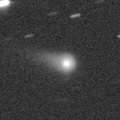
|
Now it is 13.7 mag (July 22, Ken-ichi Kadota). It is expected to brighten up to 12 mag in 2023. In the Northern Hemisphere, it stays observable in good condition for a long time. In the Southern Hemisphere, it locates extremely low in 2022, but it will be observable in good condition in 2023.
Date(TT) R.A. (2000) Decl. Delta r Elong. m1 Best Time(A, h)
Aug. 6 13 26.14 27 48.0 4.584 4.191 61 13.7 20:33 (100, 38)
Aug. 13 13 25.13 26 11.5 4.643 4.161 55 13.6 20:24 (100, 33)
|

|
Now it is 15.0 mag (Aug. 4, Michael Jager). Now it is fading. It stays 13-14 mag for a while. It is observable in excellent condition in the Southern Hemisphere. It locates somewhat low in the Northern Hemisphere.
Date(TT) R.A. (2000) Decl. Delta r Elong. m1 Best Time(A, h)
Aug. 6 23 4.94 -26 14.3 1.161 2.102 150 13.9 2:09 ( 0, 29)
Aug. 13 22 58.81 -27 8.3 1.177 2.142 155 14.1 1:35 ( 0, 28)
|

|
Appearing in the morning sky. Now it is 15.9 mag (July 30A. Diepvens).
Date(TT) R.A. (2000) Decl. Delta r Elong. m1 Best Time(A, h)
Aug. 6 6 21.28 29 8.1 6.766 6.011 38 14.0 3:37 (247, 18)
Aug. 13 6 26.61 29 6.0 6.695 6.013 44 14.0 3:44 (250, 24)
|
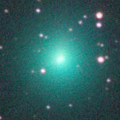
|
Now it is very bright as 11.3 mag (July 5, Thomas Lehmann). It will be fading after this. In the Southern Hemisphere, it stays observable in good condition for a long time. In the Northern Hemisphere, it will never be observable again.
Date(TT) R.A. (2000) Decl. Delta r Elong. m1 Best Time(A, h)
Aug. 6 4 38.73 -44 51.4 1.954 2.136 85 14.0 3:37 (321, -7)
Aug. 13 4 49.76 -49 58.1 1.994 2.221 88 14.4 3:44 (328, -8)
|

|
Now it is 13.8 mag (July 19, Thomas Lehmann). It becomes too low to observe in mid August in the Northern Hemisphere, or in late September in the Southern Hemisphere.
Date(TT) R.A. (2000) Decl. Delta r Elong. m1 Best Time(A, h)
Aug. 6 12 4.80 -0 32.5 2.746 2.202 48 14.3 20:33 ( 85, 6)
Aug. 13 12 17.72 -2 4.4 2.803 2.205 44 14.3 20:24 ( 84, 4)
|

|
Now it is 11.2 mag (July 4, Ken-ichi Kadota). It is brighter than originally predicted by 3 mag. It brightened up to 6.7 mag in early May (May 10, Mike Olason). Now it is fading rapidly. The condition is very bad in this apparition. It is observable only in the extremely low sky from mid May to mid July in the Northern Hemisphere, or from early June to early August in the Southern Hemisphere.
Date(TT) R.A. (2000) Decl. Delta r Elong. m1 Best Time(A, h)
Aug. 6 10 54.70 10 7.3 2.586 1.756 27 14.3 20:33 (103, -2)
Aug. 13 11 10.34 8 30.9 2.701 1.839 25 14.7 20:24 (102, -3)
|
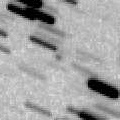
|
It is expected to brighten up to 13-14 mag in July. But actually, it is not detected, fainter than 17 mag (July 10, Martin Masek). In the Southern Hemisphere, it stays observable in good condition after this. In the Northern Hemisphere, it is not observable at all.
Date(TT) R.A. (2000) Decl. Delta r Elong. m1 Best Time(A, h)
Aug. 6 11 50.63 -42 11.6 1.537 1.534 70 14.8 20:33 ( 52,-19)
Aug. 13 12 19.92 -38 26.4 1.700 1.595 66 15.2 20:24 ( 54,-16)
|

|
It brightened up to 12.8 mag from late June to early July (June 23, Thomas Lehmann). It is not observable after this.
Date(TT) R.A. (2000) Decl. Delta r Elong. m1 Best Time(A, h)
Aug. 6 7 55.34 15 36.3 1.712 0.791 16 14.9 3:37 (245, -7)
Aug. 13 8 25.51 14 2.1 1.808 0.874 15 15.9 3:44 (248, -7)
|

|
Now it is 14.5 mag (June 19, ATLAS South Africa). It was expected to brighten up to 13 mag in spring. But actually, it is fainter than originally expected. In the Southern Hemisphere, it stays observable in good condition for a long time. In the Northern Hemisphere, it is not observable until autumn.
Date(TT) R.A. (2000) Decl. Delta r Elong. m1 Best Time(A, h)
Aug. 6 6 48.30 -39 59.6 3.463 3.169 64 15.1 3:37 (303,-24)
Aug. 13 6 48.66 -40 38.1 3.439 3.180 66 15.1 3:44 (307,-19)
|

|
Now it is very bright in outburst as 14.9 mag (Aug. 6, Martin Masek). It was extremely faint as 20.6 mag on July 29 (Takaaki Oribe). But it suddenly brightened by 4-5 mag up to 16.0 mag on Aug. 1 (ATLAS-MLO, Mauna Loa). It stays observable in good condition for a while.
Date(TT) R.A. (2000) Decl. Delta r Elong. m1 Best Time(A, h)
Aug. 6 18 27.27 14 33.4 1.535 2.324 130 15.3 21:27 ( 0, 69)
Aug. 13 18 24.54 13 17.0 1.531 2.282 126 15.3 20:57 ( 0, 68)
|

|
Now it is 15.2 mag (June 28, S. L. Ferreira). It stays at 15-16 mag for a long time. In the Southern Hemisphere, it stays observable in excellent condition for a long time. In the Northern Hemiphere, it is not observable after this.
Date(TT) R.A. (2000) Decl. Delta r Elong. m1 Best Time(A, h)
Aug. 6 14 26.16 -49 11.5 5.205 5.421 96 15.4 20:33 ( 28, -4)
Aug. 13 14 23.94 -49 0.9 5.331 5.441 90 15.5 20:24 ( 31, -6)
|
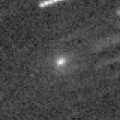
|
Now it is 16.5 mag (July 31, Toshihiko Ikemura, Hirohisa Sato). It is observable at 15-16 mag in good condition from July to August.
Date(TT) R.A. (2000) Decl. Delta r Elong. m1 Best Time(A, h)
Aug. 6 17 2.69 12 45.6 1.071 1.746 113 15.5 20:33 ( 20, 67)
Aug. 13 16 33.12 14 15.1 1.195 1.710 101 15.5 20:24 ( 46, 63)
|

|
Now it is 16.8 mag (July 28, J.-G. Bosch, J. Nicolas, F. Kugel). It is expected to brighten up to 12 mag from winter to summer in 2023. In the Northern Hemisphere, it stays observable in good condition until 2023 spring. It will be observable in good condition after August also in the Southern Hemisphere.
Date(TT) R.A. (2000) Decl. Delta r Elong. m1 Best Time(A, h)
Aug. 6 4 46.85 37 45.7 4.052 3.641 59 15.7 3:37 (247, 40)
Aug. 13 4 53.11 37 18.9 3.899 3.582 64 15.5 3:44 (250, 45)
|

|
Now it is 17.6 mag (Aug. 4, W. Hasubick). It is expected to brighten very rapidly up to 11-12 mag in winter, and it will be observable in excellent condition.
Date(TT) R.A. (2000) Decl. Delta r Elong. m1 Best Time(A, h)
Aug. 6 4 53.13 13 45.3 2.357 2.049 60 15.7 3:37 (273, 28)
Aug. 13 5 8.81 13 54.7 2.274 2.024 62 15.5 3:44 (276, 32)
|
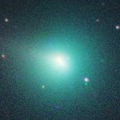
|
It brightened up to 8.8 mag from winter to early spring (Jan. 31, Chris Wyatt). Now it is fading. It has already faded down to 16.8 mag (July 30, J. Nicolas, F. Kugel). It locates extremely low in the Southern Hemisphere. It will be unobservable in August in the Northern Hemisphere.
Date(TT) R.A. (2000) Decl. Delta r Elong. m1 Best Time(A, h)
Aug. 6 11 1.00 29 27.2 3.194 2.369 29 15.5 20:33 (118, 11)
Aug. 13 11 15.01 27 58.9 3.271 2.421 27 15.7 20:24 (118, 9)
|

|
Now it is 16.3 mag (July 29, Ken-ichi Kadota). It is expected to brighten up to 15 mag in autumn, and it will be observable in good condition.
Date(TT) R.A. (2000) Decl. Delta r Elong. m1 Best Time(A, h)
Aug. 6 1 18.32 6 20.6 1.609 2.209 112 15.8 3:37 (338, 60)
Aug. 13 1 24.44 6 28.7 1.529 2.195 117 15.7 3:44 (352, 61)
|
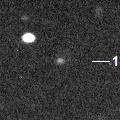
|
Now it is 15.4 mag (Aug. 3, N. Paul, E. Cortes). It will brighten up to 15 mag from summer to winter, and it stays observable in good condition. It locates somwwhat low in the Southern Hemisphere.
Date(TT) R.A. (2000) Decl. Delta r Elong. m1 Best Time(A, h)
Aug. 6 5 35.38 19 27.8 2.861 2.328 49 15.9 3:37 (261, 23)
Aug. 13 5 49.20 19 40.3 2.800 2.327 52 15.8 3:44 (264, 27)
|
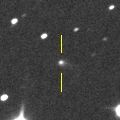
|
Appearing in the morning sky. It will brighten up to 14 mag in early 2023, and it will be observable in good condition.
Date(TT) R.A. (2000) Decl. Delta r Elong. m1 Best Time(A, h)
Aug. 6 7 13.31 17 17.4 4.675 3.791 26 15.9 3:37 (250, 2)
Aug. 13 7 22.97 17 17.1 4.601 3.762 30 15.9 3:44 (254, 7)
|

|
Now it is 17.1 mag (Aug. 4, R. Fichtl). It will brighten rapidly up to 15 mag in September, and it will be observable in good condition.
Date(TT) R.A. (2000) Decl. Delta r Elong. m1 Best Time(A, h)
Aug. 6 0 56.61 19 54.2 0.893 1.582 111 16.2 3:37 (340, 74)
Aug. 13 1 10.82 17 2.6 0.827 1.570 116 16.0 3:44 (359, 72)
|
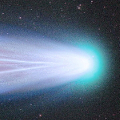
|
It brightened up to 3 mag from mid December to late December. Now it is fading. It is observable in good condition in the Southern Hemisphere. It is getting observable again also in the Northern Hemisphere. No observations have been reported since June.
Date(TT) R.A. (2000) Decl. Delta r Elong. m1 Best Time(A, h)
Aug. 6 16 0.73 -24 57.5 2.956 3.435 109 16.2 20:33 ( 23, 26)
Aug. 13 15 58.63 -24 9.2 3.156 3.518 102 16.5 20:24 ( 28, 25)
|

|
Now it is 16.4 mag (July 21, J.-C. Merlin). It will be fading gradually after this. It locates somewhat low in the Northern Hemisphere.
Date(TT) R.A. (2000) Decl. Delta r Elong. m1 Best Time(A, h)
Aug. 6 19 24.84 -27 49.9 2.335 3.282 154 16.3 22:25 ( 0, 27)
Aug. 13 19 21.64 -28 5.4 2.393 3.294 147 16.4 21:55 ( 0, 27)
|
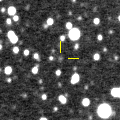
|
Now it is 16.8 mag (June 1, ATLAS South Africa). It will brighten up to 13 mag from 2024 to 2025.
Date(TT) R.A. (2000) Decl. Delta r Elong. m1 Best Time(A, h)
Aug. 6 8 16.12 -24 46.7 8.239 7.531 43 16.5 3:37 (278,-34)
Aug. 13 8 21.10 -25 7.6 8.200 7.495 43 16.4 3:44 (282,-28)
|

|
Now it is 16.0 mag (Aug. 3, ATLAS-MLO, Mauna Loa). It brightened up to 14 mag from 2020 to 2021. Now it is fading slowly. It is observable at 16.5-17 mag in 2022.
Date(TT) R.A. (2000) Decl. Delta r Elong. m1 Best Time(A, h)
Aug. 6 0 52.42 -15 34.3 3.163 3.837 125 16.5 3:37 (354, 39)
Aug. 13 0 51.51 -16 8.2 3.109 3.855 131 16.5 3:27 ( 0, 39)
|
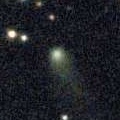
|
Now it is 16.0 mag (Aug. 1, Toshihiko Ikemura, Hirohisa Sato). It stays observable at 16 mag from 2021 to 2022. It locates low in the Southern Hemisphere.
Date(TT) R.A. (2000) Decl. Delta r Elong. m1 Best Time(A, h)
Aug. 6 15 23.80 41 45.8 5.324 5.292 82 16.6 20:33 (115, 64)
Aug. 13 15 25.27 41 19.5 5.407 5.316 79 16.6 20:24 (113, 61)
|

|
Now it is 16.4 mag (July 23, ATLAS Chile). It will brighten up to 15 mag in autumn, and it will be observable in excellent condition.
Date(TT) R.A. (2000) Decl. Delta r Elong. m1 Best Time(A, h)
Aug. 6 2 29.42 7 13.7 2.206 2.520 95 16.7 3:37 (309, 52)
Aug. 13 2 35.53 8 23.7 2.108 2.502 100 16.6 3:44 (318, 57)
|

|
It brightened up to 14 mag in 2021. Now it is fading. It has already faded down to 16.2 mag (Aug. 3, ATLAS-MLO, Mauna Loa). It is observable at 16-17 mag in 2022.
Date(TT) R.A. (2000) Decl. Delta r Elong. m1 Best Time(A, h)
Aug. 6 0 6.50 13 31.5 5.258 5.904 125 16.6 3:10 ( 0, 69)
Aug. 13 0 3.55 13 58.2 5.212 5.941 132 16.6 2:40 ( 0, 69)
|
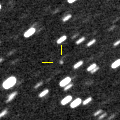
|
Now it is 17.1 mag (Apr. 17, ATLAS South Africa). It will brighten up to 14 mag in 2023. In the Southern Hemisphere, it stays observable in good condition for a long time although it became extremely low temporarily in June. In the Northern Hemisphere, it is not observable until late August.
Date(TT) R.A. (2000) Decl. Delta r Elong. m1 Best Time(A, h)
Aug. 6 6 39.74 -10 25.4 4.902 4.241 44 16.7 3:37 (278, -7)
Aug. 13 6 41.07 -10 50.9 4.796 4.201 48 16.6 3:44 (283, -1)
|
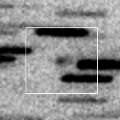
|
Now it is 17.3 mag (Aug. 5, N. Paul, E. Cortes). It stays observable at 16 mag from summer to winter. In the Southern Hemisphere, it locates low until October.
Date(TT) R.A. (2000) Decl. Delta r Elong. m1 Best Time(A, h)
Aug. 6 5 53.28 30 6.1 2.159 1.612 45 16.7 3:37 (249, 24)
Aug. 13 6 16.87 29 38.7 2.114 1.597 46 16.7 3:44 (251, 26)
|

|
It brightened up to 12.3 mag from spring to summer in 2021 (June 15, 2021, Marco Goiato). Now it is fading. It has already faded down to 15.9 mag (July 19, ATLAS-MLO, Mauna Loa).
Date(TT) R.A. (2000) Decl. Delta r Elong. m1 Best Time(A, h)
Aug. 6 12 3.38 29 34.3 6.095 5.400 43 16.7 20:33 (111, 22)
Aug. 13 12 5.25 29 18.4 6.199 5.445 38 16.8 20:24 (113, 19)
|

|
Now it is 17.0 mag (July 23, iTelescope Observatory, Mayhill). It will be observable at 16.5 mag in good condition from summer to autumn.
Date(TT) R.A. (2000) Decl. Delta r Elong. m1 Best Time(A, h)
Aug. 6 3 1.35 23 35.9 2.134 2.259 83 16.8 3:37 (279, 56)
Aug. 13 3 10.44 24 24.0 2.074 2.278 88 16.8 3:44 (284, 62)
|
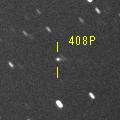
|
Now it is 18.6 mag (July 29, Pan-STARRS 2, Haleakala). It will be observable at 16 mag in excellent condition from autumn to winter.
Date(TT) R.A. (2000) Decl. Delta r Elong. m1 Best Time(A, h)
Aug. 6 4 2.47 9 42.1 3.637 3.479 73 16.8 3:37 (285, 36)
Aug. 13 4 9.17 9 24.7 3.542 3.477 78 16.8 3:44 (291, 42)
|

|
It has not been observed yet in this apparition. It will brighten very rapidly, and it is expected to brighten up to 15 mag in September. It is not observable in the Southern Hemisphere. It locates extremely low even in the Northern Hemisphere.
Date(TT) R.A. (2000) Decl. Delta r Elong. m1 Best Time(A, h)
Aug. 6 6 20.89 29 5.7 1.541 0.987 38 17.7 3:37 (247, 19)
Aug. 13 7 0.33 27 13.7 1.527 0.937 36 16.8 3:44 (248, 17)
|

|
It brightened up to 14.2 mag in 2021 summer (July 18, 2021, Taras Prystavski). Now it is fading. It has already faded down to 16.6 mag (July 26, ATLAS Chile). In the Southern Hemisphere, it stays observable in good condition for a long time. It locates somewhat low in the Northern Hemisphere.
Date(TT) R.A. (2000) Decl. Delta r Elong. m1 Best Time(A, h)
Aug. 6 2 21.46 -25 28.9 4.703 5.081 106 16.8 3:37 (333, 24)
Aug. 13 2 20.81 -25 43.0 4.662 5.122 111 16.8 3:44 (342, 27)
|

|
Now it is 16.9 mag (July 31, Toshihiko Ikemura, Hirohisa Sato). It will be fading rapidyly, and it will be fainter than 18 mag in late August.
Date(TT) R.A. (2000) Decl. Delta r Elong. m1 Best Time(A, h)
Aug. 6 16 48.51 -14 33.5 0.790 1.559 119 16.9 20:33 ( 15, 39)
Aug. 13 16 5.99 -12 24.6 0.960 1.532 101 17.3 20:24 ( 33, 36)
|

|
Now it is 16.9 mag (Aug. 3, Jean-Francois Soulier). In 2022, it stays observable at 17 mag for a long time.
Date(TT) R.A. (2000) Decl. Delta r Elong. m1 Best Time(A, h)
Aug. 6 3 35.01 25 32.8 0.435 1.001 75 17.0 3:37 (271, 50)
Aug. 13 4 18.64 27 15.8 0.468 0.980 72 17.1 3:44 (267, 49)
|

|
Now it is 16.8 mag (Aug. 3, Martin Masek). It is expected to brighten up to 7 mag in early 2024. In the Southern Hemisphere, it stays observable in good condition for a long time. It will appear in the morning sky in mid August also in the Northern Hemisphere, but it stays low in 2022.
Date(TT) R.A. (2000) Decl. Delta r Elong. m1 Best Time(A, h)
Aug. 6 5 55.24 -20 38.7 6.853 6.395 59 17.2 3:37 (292, -4)
Aug. 13 5 59.33 -21 15.3 6.732 6.335 62 17.2 3:44 (297, 1)
|

|
Now it is 16.1 mag (June 12, ATLAS-MLO, Mauna Loa). It was observed at 15 mag in 2021. Now it is fading. It stays observable at 16-17 mag for a while in 2022.
Date(TT) R.A. (2000) Decl. Delta r Elong. m1 Best Time(A, h)
Aug. 6 17 50.54 30 41.0 5.048 5.534 113 17.2 20:51 ( 0, 86)
Aug. 13 17 47.94 30 33.3 5.130 5.560 110 17.3 20:24 ( 8, 85)
|
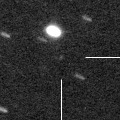
|
Now it is 16.9 mag (July 29, Ken-ichi Kadota). It is expected to brighten up to 8 mag in 2023 July. In 2022, it stays observable in good condition while the comet will be brightening gradually.
Date(TT) R.A. (2000) Decl. Delta r Elong. m1 Best Time(A, h)
Aug. 6 3 34.30 6 56.0 4.596 4.539 80 17.4 3:37 (293, 40)
Aug. 13 3 33.97 6 24.4 4.406 4.474 87 17.2 3:44 (302, 46)
|
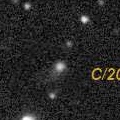
|
Now it is 17.3 mag (July 18, ATLAS-MLO, Mauna Loa). It stays observable at 17-18 mag for a long time until 2024.
Date(TT) R.A. (2000) Decl. Delta r Elong. m1 Best Time(A, h)
Aug. 6 13 16.99 4 40.0 9.226 8.818 63 17.2 20:33 ( 78, 24)
Aug. 13 13 17.00 4 35.5 9.332 8.819 56 17.3 20:24 ( 81, 20)
|

|
Now it is 16.6 mag (July 29, ATLAS-MLO, Mauna Loa). Fading slowly. In the Northern Hemisphere, it stays observable in good condition for a long time. In the Southern Hemisphere, it is not observable after this.
Date(TT) R.A. (2000) Decl. Delta r Elong. m1 Best Time(A, h)
Aug. 6 17 34.52 68 6.2 9.304 9.309 87 17.4 20:33 (180, 57)
Aug. 13 17 27.88 67 46.5 9.324 9.322 86 17.4 20:24 (176, 57)
|

|
It brightened very rapidly up to 15.5 mag from autumn to winter (Nov. 2, Toshihiko Ikemura, Hirohisa Sato). Now it is fading. Appearing in the morning sky.
Date(TT) R.A. (2000) Decl. Delta r Elong. m1 Best Time(A, h)
Aug. 6 5 55.36 16 34.5 4.760 4.102 44 17.4 3:37 (261, 17)
Aug. 13 6 2.66 16 18.9 4.700 4.117 49 17.5 3:44 (265, 23)
|

|
Now it is 16.6 mag (Aug. 3, ATLAS-MLO, Mauna Loa). It was observed at 16 mag from 2020 to 2021. Now it is fading. It will be fainter than 18 mag in autumn.
Date(TT) R.A. (2000) Decl. Delta r Elong. m1 Best Time(A, h)
Aug. 6 21 56.30 11 5.8 6.073 6.962 149 17.5 1:00 ( 0, 66)
Aug. 13 21 51.51 10 15.7 6.060 6.987 154 17.5 0:28 ( 0, 65)
|

|
Now it is 17.8 mag (July 26, J. Nicolas, F. Kugel). It is observable in excellent condition. But it will be fading rapidly, and it will be fainter than 18 mag in August.
Date(TT) R.A. (2000) Decl. Delta r Elong. m1 Best Time(A, h)
Aug. 6 15 31.27 -24 55.3 0.897 1.500 103 17.5 20:33 ( 30, 23)
Aug. 13 15 47.41 -28 17.6 0.953 1.516 100 17.7 20:24 ( 28, 20)
|
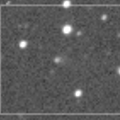
|
It was observed at 17 mag in 2021. It is observable at 17-18 mag also in 2022.
Date(TT) R.A. (2000) Decl. Delta r Elong. m1 Best Time(A, h)
Aug. 6 2 55.62 8 8.4 3.263 3.406 89 17.6 3:37 (301, 48)
Aug. 13 2 57.89 8 56.5 3.181 3.425 95 17.5 3:44 (310, 54)
|

|
Now it is 17.4 mag (July 8, J.-G. Bosch, J. Nicolas, F. Kugel). It is observable at 17 mag from spring to summer. In the Northern Hemisphere, it becomes low in summer.
Date(TT) R.A. (2000) Decl. Delta r Elong. m1 Best Time(A, h)
Aug. 6 12 44.69 -4 46.8 2.345 2.018 58 17.5 20:33 ( 75, 12)
Aug. 13 12 56.22 -7 6.6 2.406 2.018 55 17.6 20:24 ( 74, 9)
|

|
Now it is 19.0 mag (July 26, P. Carson). It stays observable at 17-18 mag in 2022. It locates somewhat low in the Southern Hemisphere.
Date(TT) R.A. (2000) Decl. Delta r Elong. m1 Best Time(A, h)
Aug. 6 2 47.01 29 36.3 5.420 5.428 85 17.6 3:37 (271, 61)
Aug. 13 2 43.20 29 41.7 5.299 5.436 92 17.6 3:44 (278, 69)
|
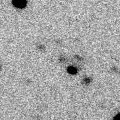
|
Now it is 17.5 mag (July 4, Michael Jager). In the Northern Hemisphere, it stays observable at 17 mag in good condition for a long time until winter. In the Southern Hemisphere, it stays extremely low for a long time.
Date(TT) R.A. (2000) Decl. Delta r Elong. m1 Best Time(A, h)
Aug. 6 5 17.29 41 19.8 3.248 2.774 53 17.7 3:37 (241, 35)
Aug. 13 5 33.06 42 7.0 3.186 2.773 57 17.7 3:44 (241, 39)
|
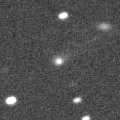
|
Now it is 17.3 mag (July 18, ATLAS-MLO, Mauna Loa). It will be unobservable in September.
Date(TT) R.A. (2000) Decl. Delta r Elong. m1 Best Time(A, h)
Aug. 6 13 26.80 -9 40.1 4.968 4.726 70 17.7 20:33 ( 65, 17)
Aug. 13 13 31.33 -10 9.3 5.068 4.729 64 17.7 20:24 ( 66, 14)
|

|
It brightened up to 17 mag in early 2022. Now it is fading. It will be fainter than 18 mag in autumn. It is not observable in the Northern Hemisphere.
Date(TT) R.A. (2000) Decl. Delta r Elong. m1 Best Time(A, h)
Aug. 6 7 23.90 -46 4.3 6.002 5.679 66 17.7 3:37 (307,-32)
Aug. 13 7 27.48 -47 10.2 6.003 5.697 67 17.8 3:44 (310,-28)
|
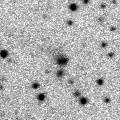
|
Now it is 17.9 mag (July 22, Katsumi Yoshimoto). It started fading before the perihelion passage. It was predicted to stay at 16 mag for a long time. But actually, it will be fainter than 18 mag in autumn. In the Northern Hemisphere, it stays observable in good condition for a long time. In the Southern Hemisphere, it is not observable until 2023.
Date(TT) R.A. (2000) Decl. Delta r Elong. m1 Best Time(A, h)
Aug. 6 17 25.57 75 30.9 3.869 3.859 81 17.8 20:33 (179, 50)
Aug. 13 17 19.52 72 55.1 3.856 3.874 83 17.8 20:24 (176, 52)
|
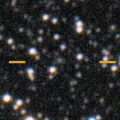
|
Now it is 16.2 mag (Aug. 3, ATLAS-MLO, Mauna Loa). It was observed at 17 mag in 2021. It is observable at 17-18 mag in 2022. It is brighter than this ephemeris recently.
Date(TT) R.A. (2000) Decl. Delta r Elong. m1 Best Time(A, h)
Aug. 6 23 26.46 0 13.9 3.388 4.222 140 17.8 2:30 ( 0, 55)
Aug. 13 23 24.43 0 2.5 3.339 4.232 147 17.8 2:01 ( 0, 55)
|

|
It approached to Sun down to 0.14 a.u. on May 15. But it was not observable around that time. Appearing in the morning sky. In the Northern Hemisphere, it stays observable at 17-18 mag in good condition from July to November. In the Southern Hemisphere, it stays extremely low.
Date(TT) R.A. (2000) Decl. Delta r Elong. m1 Best Time(A, h)
Aug. 6 4 5.80 39 3.1 1.665 1.582 67 17.9 3:37 (248, 48)
Aug. 13 4 9.82 40 4.8 1.639 1.653 72 17.9 3:44 (248, 54)
|
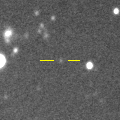
|
Now it is 18.6 mag (Aug. 4, W. Hasubick). It stays 18 mag for a long time even after the perihelion passage.
Date(TT) R.A. (2000) Decl. Delta r Elong. m1 Best Time(A, h)
Aug. 6 2 32.89 -5 18.4 4.826 5.078 98 17.9 3:37 (319, 41)
Aug. 13 2 34.24 -5 33.6 4.751 5.104 104 17.9 3:44 (329, 45)
|

|
Now it is 17.3 mag (June 27, ATLAS South Africa). Very far object. It stays 18 mag for a long time from 2021 to 2026. In the Southern Hemisphere, it stays observable in good condition for a long time. In the Northern Hemisphere, it is not observable at all.
Date(TT) R.A. (2000) Decl. Delta r Elong. m1 Best Time(A, h)
Aug. 6 8 1.15 -62 54.6 10.727 10.609 80 17.9 3:37 (326,-40)
Aug. 13 8 4.55 -63 18.1 10.732 10.601 79 17.9 3:44 (327,-37)
|

|
Now it is 18.7 mag (July 26, J.-G. Bosch, J. Nicolas, F. Kugel). It stays observable at 18 mag in good condition from August to September.
Date(TT) R.A. (2000) Decl. Delta r Elong. m1 Best Time(A, h)
Aug. 6 23 57.14 -8 40.3 1.479 2.325 136 18.0 3:01 ( 0, 46)
Aug. 13 23 57.39 -8 38.9 1.430 2.323 143 17.9 2:33 ( 0, 46)
|

|
Now it is 18.8 mag (July 25, Toshihiko Ikemura, Hirohisa Sato). It was expected to be observable at 16 mag in good condition in spring. But actually, it is fainter than predicted by 2-3 mag.
Date(TT) R.A. (2000) Decl. Delta r Elong. m1 Best Time(A, h)
Aug. 6 20 43.54 11 11.1 1.021 1.973 151 19.5 23:43 ( 0, 66)
Aug. 13 20 37.41 10 47.9 1.071 2.019 151 19.7 23:10 ( 0, 66)
|
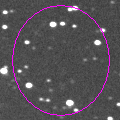
|
Now it is 20.0 mg (Aug. 4, J. Maikner). At the discovery, it was expected to be observable at 16-17 mag for a long time from 2020 to 2022. It had been lost for a long time since 2015, but the recent observations are found. Actually, it brigthens up to 20-21 mag at best.
Date(TT) R.A. (2000) Decl. Delta r Elong. m1 Best Time(A, h)
Aug. 6 0 54.35 11 0.9 5.693 6.210 116 21.3 3:37 (347, 66)
Aug. 13 0 53.99 11 7.2 5.614 6.225 123 21.3 3:30 ( 0, 66)
|
|
![]()
 117P/Helin-Roman-Alu 1
117P/Helin-Roman-Alu 1 81P/Wild 2
81P/Wild 2 C/2019 U5 ( PanSTARRS )
C/2019 U5 ( PanSTARRS ) 9P/Tempel 1
9P/Tempel 1 29P/Schwassmann-Wachmann 1
29P/Schwassmann-Wachmann 1 C/2021 F1 ( Lemmon-PanSTARRS )
C/2021 F1 ( Lemmon-PanSTARRS ) 116P/Wild 4
116P/Wild 4 45P/Honda-Mrkos-Pajdusakova
45P/Honda-Mrkos-Pajdusakova C/2021 T2 ( Fuls )
C/2021 T2 ( Fuls ) 169P/NEAT
169P/NEAT C/2020 Y2 ( ATLAS )
C/2020 Y2 ( ATLAS ) 285P/LINEAR
285P/LINEAR C/2018 U1 ( Lemmon )
C/2018 U1 ( Lemmon ) C/2022 L1 ( Catalina )
C/2022 L1 ( Catalina ) C/2021 Y1 ( ATLAS )
C/2021 Y1 ( ATLAS ) 118P/Shoemaker-Levy 4
118P/Shoemaker-Levy 4 19P/Borrelly
19P/Borrelly 61P/Shajn-Schaldach
61P/Shajn-Schaldach 119P/Parker-Hartley
119P/Parker-Hartley C/2020 S4 ( PanSTARRS )
C/2020 S4 ( PanSTARRS ) 327P/Van Ness
327P/Van Ness C/2021 A1 ( Leonard )
C/2021 A1 ( Leonard ) 152P/Helin-Lawrence
152P/Helin-Lawrence C/2021 G2 ( ATLAS )
C/2021 G2 ( ATLAS ) 246P/NEAT
246P/NEAT C/2020 H6 ( ATLAS )
C/2020 H6 ( ATLAS ) P/2022 L3 ( ATLAS )
P/2022 L3 ( ATLAS ) C/2020 F5 ( MASTER )
C/2020 F5 ( MASTER ) C/2021 X1 ( Maury-Attard )
C/2021 X1 ( Maury-Attard ) 157P/Tritton
157P/Tritton C/2020 J1 ( SONEAR )
C/2020 J1 ( SONEAR ) 44P/Reinmuth 2
44P/Reinmuth 2 408P/2020 M7 ( Novichonok-Gerke )
408P/2020 M7 ( Novichonok-Gerke ) 255P/Levy
255P/Levy C/2019 F1 ( ATLAS-Africano )
C/2019 F1 ( ATLAS-Africano ) C/2022 N1 ( Attard-Maury )
C/2022 N1 ( Attard-Maury ) 107P/(4015) Wilson-Harrington
107P/(4015) Wilson-Harrington C/2021 S3 ( PanSTARRS )
C/2021 S3 ( PanSTARRS ) C/2020 O2 ( Amaral )
C/2020 O2 ( Amaral ) C/2021 T4 ( Lemmon )
C/2021 T4 ( Lemmon ) C/2020 F2 ( ATLAS )
C/2020 F2 ( ATLAS ) C/2019 O3 ( Palomar )
C/2019 O3 ( Palomar ) P/2021 N2 ( Fuls )
P/2021 N2 ( Fuls ) C/2019 T3 ( ATLAS )
C/2019 T3 ( ATLAS ) 444P/2022 C4 ( WISE-PanSTARRS )
444P/2022 C4 ( WISE-PanSTARRS ) 422P/2021 L1 ( Christensen )
422P/2021 L1 ( Christensen ) 100P/Hartley 1
100P/Hartley 1 C/2020 U4 ( PanSTARRS )
C/2020 U4 ( PanSTARRS ) C/2021 QM45 ( PanSTARRS )
C/2021 QM45 ( PanSTARRS ) 99P/Kowal 1
99P/Kowal 1 C/2020 F7 ( Lemmon )
C/2020 F7 ( Lemmon ) C/2020 U5 ( PanSTARRS )
C/2020 U5 ( PanSTARRS ) 395P/2020 H1 ( Catalina-NEAT )
395P/2020 H1 ( Catalina-NEAT ) (3200) Phaethon
(3200) Phaethon 378P/2019 E2 ( McNaught )
378P/2019 E2 ( McNaught ) C/2019 E3 ( ATLAS )
C/2019 E3 ( ATLAS ) 442P/2022 G1 ( McNaught )
442P/2022 G1 ( McNaught ) 325P/Yang-Gao
325P/Yang-Gao C/2014 F3 ( Sheppard-Trujillo )
C/2014 F3 ( Sheppard-Trujillo )![]()





























































